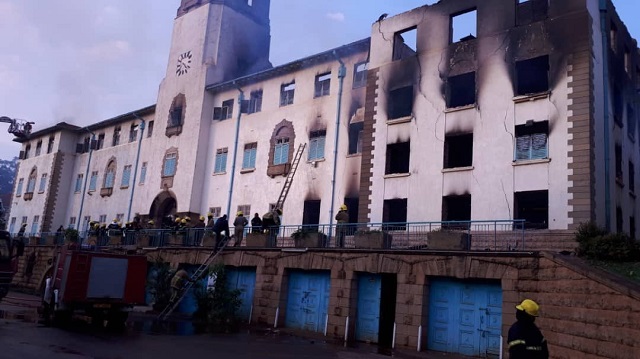
Kampala, Uganda | THE INDEPENDENT | The Makerere University’s main building widely known as the ivory tower that was razed by fire over the weekend was not insured.
According to the university administration, the building whose structure mainly constituted of wood and steel was never insured because insuring it was expensive.
Professor Barnabas Nawangwe, the university vice-chancellor says that although they considered having the building insured at the height of school fires in the country, they faced budget constraints referring to the matter for future considerations.
As a result, reconstruction of the 79-year-old building which holds a rich history will have to be footed by either the university or government. As of now, the cost needed for this restoration project remains unknown.
Nawangwe adds that it’s not only the main building that is not insured. Other key installations such as the Senate building and even the main library are not insured.
Last year, the chief government valuer made a valuation attaching value to the said structures. Records indicate that the burnt main building was valued at 15.4 billion shillings, the main library at 21.6 billion shillings and the senate building at 20.5 billion shillings.
Insurance is an important aspect of the risk management of property with the objective of keeping the owner financially whole following a loss.
Kago Wamuyu, an insurance consultant says that apart from risks to the physical building, owners and employers may need to consider other potential liabilities as well as risks to collections which may be integral to the significance of the building.
Research from other countries indicates that the majority of the unique forms of property like monuments, heritage sites, religious relics are hard to value as it would be difficult to tag price on sentiment, history, and international renown.
For instance, while explaining why the 800-year-old Notre Dame Cathedral was not insured, University of Notre Dame Law Professor Bruce Huber argued that the insurance business operates by spreading the risk over a large number of similarly situated insured parties and obviously in the case of unique assets, there is not a large pool.
Meanwhile, the weekend inferno that razed the 79-year-old iconic ivory tower at Makerere University has exposed the laxity at the oldest and best institution of higher learning in the country.
Ideally one would expect that such an institution would have strong systems, precautions, and policies that can help in case something of such gravity happens. However, for this 98-year-old university which is the country’s hub of knowledge and research, it seems there was nothing.
According to available information, the razed building just like many others lacked fire systems that could alert security about the danger. However in this case, the fire was identified by police officers at the Nateete CCTV control center before anybody at the campus could make a distress call.
“The building lacked fire systems,” Professor Barnabas Nawangwe the vice-chancellor confessed adding that they had only placed fire extinguishers inside the building.
Simon Sagala Mulindwa, a former employee at the university wonders why the university delayed to put up fire alert systems in the building and others yet they have had two incidents of fire. “That time could have given us a lesson. But it seems we learnt nothing from the experience.”
In the 1990’s, the cash office reportedly caught fire but it was put out before causing any major damages. Again in 2018, a similar incident happened in the central registry with reports pointing at the old wiring system that caused a short circuit.
Joseph Mugisa, director Fire and Rescue Services also notes that even when the firefighters touched base, they faced huge challenges in fighting the fire at the scene as the entire university lacks a hydrant. This led to wastage of time as the fire trucks made longer journeys to the fire and rescue headquarters to be refilled.
Professor Nawagwe takes the blame saying that although the university has risk management and business continuity policies, they are outdated which makes them ineffective. He says that the happening has now given them a wake-up call to review the policies and subsequently install required equipment for such incidents.
*****
URN
 The Independent Uganda: You get the Truth we Pay the Price
The Independent Uganda: You get the Truth we Pay the Price


